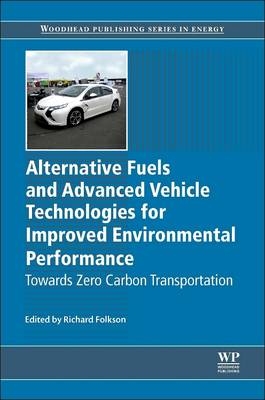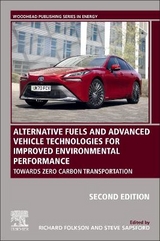
Alternative Fuels and Advanced Vehicle Technologies for Improved Environmental Performance
Woodhead Publishing Ltd (Verlag)
978-0-08-101342-7 (ISBN)
- Titel erscheint in neuer Auflage
- Artikel merken
Part I considers the role of alternative fuels such as electricity, alcohol, and hydrogen fuel cells, as well as advanced additives and oils, in environmentally sustainable transport. Part II explores methods of revising engine and vehicle design to improve environmental performance and fuel economy. It contains chapters on improvements in design, aerodynamics, combustion, and transmission. Finally, Part III outlines developments in electric and hybrid vehicle technologies, and provides an overview of the benefits and limitations of these vehicles in terms of their environmental impact, safety, cost, and design practicalities.
Alternative Fuels and Advanced Vehicle Technologies is a standard reference for professionals, engineers, and researchers in the automotive sector, as well as vehicle manufacturers, fuel system developers, and academics with an interest in this field.
Richard Folkson is Royal Academy of Engineering Visiting Professor for Innovation and Design and Deputy President of the Institution of Mechanical Engineers.
Contributor contact details
Woodhead Publishing Series in Energy
Chapter 1: Introduction
Abstract:
1.1 Introduction
1.2 Technology roadmaps to deliver low carbon targets
1.3 Vehicle technology contributions to low carbon targets
1.4 Powertrain technology contributions to low carbon targets
1.5 Regulatory requirements and consumer trends
1.6 Traffic management factors
1.7 Global manufacturing and consumer trends
1.8 Commercial vehicles and buses
1.9 Electrification of transport technology
1.10 Current and future trends
1.11 Affordability and consumer appeal
1.12 Long-term vision: solar energy/hydrogen economy
1.13 Conclusion
1.14 Sources of further information and advice
1.15 Acknowledgements
Part I: Alternative fuels, advanced additives and oils to improve environmental performance of vehicles
Chapter 2: The role of alternative and renewable liquid fuels in environmentally sustainable transport
Abstract:
2.1 Introduction: competing fuels and energy carriers
2.2 Market penetration of biodiesel
2.3 Market penetration of alcohol fuels
2.4 Future provision of alternative liquid fuels: the biomass limit
2.5 Beyond the biomass limit: sustainable organic fuels for transport (SOFT)
2.6 Renewable fuels within an integrated renewable energy system
2.7 Conclusions
2.8 Acknowledgements
2.10 Appendix: abbreviations
Chapter 3: Using alternative and renewable liquid fuels to improve the environmental performance of internal combustion engines: key challenges and blending technologies
Abstract:
3.1 Introduction
3.2 The use of biodiesel in internal combustion engines: fatty acid methyl esters (FAMEs) and hydrogenated vegetable oil (HVO)
3.3 Alcohol fuels: physico-chemical properties
3.4 Alcohol fuels for spark-ignition engines: effects on performance and efficiency
3.5 Alcohol fuels for spark-ignition engines: pollutant emissions, deposits and lubricant dilution
3.6 Alcohol fuels for compression-ignition engines
3.7 Vehicle and blending technologies for alternative liquid fuels: flexible-fuel vehicles
3.8 Vehicle and blending technologies for alternative liquid fuels: ethanol-gasoline and methanol-gasoline bi-fuel vehicles
3.9 Vehicle and blending technologies for alternative liquid fuels: tri-flex-fuel vehicles and iso-stoichiometric ternary blends
3.10 Conclusions
3.11 Acknowledgements
3.13 Appendix: abbreviations
Chapter 4: Alternative and renewable gaseous fuels to improve vehicle environmental performance
Abstract:
4.1 Introduction
4.2 Fossil natural gas
4.3 Fossil natural gas production, transmission and distribution
4.4 Natural gas engines and vehicles
4.5 Biomethane/biogas
4.6 Biogas production, distribution and storage
4.7 Liquid petroleum gas (LPG)
4.8 LPG production, distribution, storage and use in vehicles
4.9 Hydrogen
4.10 Hydrogen production, distribution, storage and use in vehicles
4.11 Life-cycle analysis of alternative gaseous fuels
4.12 Future trends
Chapter 5: Electricity and hydrogen as energy vectors for transportation vehicles
Abstract:
5.1 Introduction
5.2 Overview of hydrogen production
5.3 Overview of electricity production
5.4 Hydrogen storage and transportation
5.5 Conclusions
Chapter 6: Advanced engine oils to improve the performance of modern internal combustion engines
Abstract:
6.1 Introduction
6.2 The role of the lubricant in a modern internal combustion engine
6.3 The composition of a typical modern engine lubricant
6.4 Diesel engine lubricant challenges
6.5 Gasoline engine lubrication challenges
6.6 Industry and original equipment manufacturer (OEM) specifications for engine oils
6.7 Lubricating modern engines in developing markets
6.8 Future engine oil evolution
6.9 Conclusions
6.10 Acknowledgements
6.11 Sources of further information and advice
Chapter 7: Advanced fuel additives for modern internal combustion engines
Abstract:
7.1 Introduction
7.2 Additive types and their impact on conventional and advanced fuels
7.3 Impacts of additives on combustion characteristics
7.4 Diesel performance and deposit control additives
7.5 Gasoline performance and deposit control additives
7.6 Conclusions and future trends
7.7 Sources of further information and advice
Part II: Improving engine and vehicle design
Chapter 8: Internal combustion engine cycles and concepts
Abstract:
8.1 Introduction
8.2 Ideal engine operation cycles
8.3 Alternative engine operating cycles
8.4 Comparison of engine cycle performance
8.5 Advantages and limitations of internal combustion engines
8.6 Conclusions and future trends
8.7 Sources of further information and advice
Chapter 9: Improving the environmental performance of heavy-duty vehicles and engines: key issues and system design approaches
Abstract:
9.1 Introduction: classifying engine and vehicle types
9.2 The use of alternative fuels to improve environmental performance
9.3 Electric, hydraulic, and flywheel hybrid powertrains for improved fuel economy
9.4 Vehicle emissions and fuel economy regulations
9.5 Improving vehicle design to meet environmental regulations
9.6 Improving engine design to meet environmental regulations
9.7 Developments in light-duty diesel engine technologies
9.8 A system design approach to address challenges in advanced engine and vehicle technologies
9.9 Summary of next-generation technologies for heavy-duty vehicles
9.11 Appendix: units and unit conversion
Chapter 10: Improving the environmental performance of heavyduty vehicles and engines: particular technologies
Abstract:
10.1 Introduction
10.2 Fuel injection systems and engine performance
10.3 Conventional combustion technologies and engine performance
10.4 Advanced low-temperature combustion systems
10.5 Engine air flow and turbocharging systems
10.6 Engine downsizing, down-speeding, and down-breathing
10.7 Mechanical and electrical supercharging systems for improved emissions control and performance
10.8 Turbocompounding to improve engine performance
10.9 Exhaust gas recirculation (EGR) systems
10.10 Improving conventional valvetrains and the use of variable valve actuation (VVA)
10.11 Heavy-duty diesel engine cooling and thermal management systems
10.12 Aftertreatment technologies for emissions control
10.13 Waste heat recovery (WHR) systems
10.14 Engine mechanical friction reduction technologies
10.15 Electronic controls and on-board diagnostic (OBD) systems to optimize engine performance
10.16 Development of natural gas engines
10.17 Future trends
10.19 Appendix: units and unit conversion
Chapter 11: Advanced and conventional internal combustion engine materials
Abstract:
11.1 Introduction
11.2 Advanced internal combustion (IC) engine materials: compact graphite iron (CGI)
11.3 Graphite/carbon and carbon/carbon fibre-reinforced polymer composites (CFRPs)
11.4 Advanced polymers: polyamides for manufacturing intake manifolds
11.5 Advanced alloys and ceramics for manufacturing valves and other components
11.6 Materials for particular components in IC engines
Chapter 12: Advanced transmission technologies to improve vehicle performance
Abstract:
12.1 Introduction
12.2 Manual transmission: six-speed front-wheel-drive SG6-310
12.3 Dual-clutch transmission: seven-speed front-wheel-drive 7G-DCT
12.4 Automatic transmission: seven-speed 7G-Tronic Plus
12.5 Continuously variable transmission: front-wheel-drive CVT AUTOTRONIC
12.6 P2 hybrid transmission
12.7 Two-mode hybrid transmission advanced hybrid system-cars (AHS-C)
12.8 Automated commercial vehicle transmission: 16-speed G260-16
Chapter 13: Sustainable design and manufacture of lightweight vehicle structures
Abstract:
13.1 Introduction
13.2 The value of mass reduction
13.3 General challenges and opportunities
13.4 Possible architectures of the next-generation vehicle
13.5 Specific lightweighting technologies
13.6 Future trends
13.7 Acknowledgements
Chapter 14: Improving vehicle rolling resistance and aerodynamics
Abstract:
14.1 Introduction
14.2 Overview of vehicle aerodynamics
14.3 Rolling resistance in vehicles
14.4 Advanced vehicle design for drag reduction
14.5 Advanced tire design and materials
14.6 Conclusions and future trends
Chapter 15: Mechanical and electrical flywheel hybrid technology to store energy in vehicles
Abstract:
15.1 Introduction
15.2 The development of flywheel technology
15.3 Types and properties of flywheels
15.4 Transmissions for flywheels
15.5 Performance evaluation of flywheel hybrid vehicles
15.6 Technical challenges in flywheel development
15.7 Conclusions and future trends
Chapter 16: Hydraulic and pneumatic hybrid powertrains for improved fuel economy in vehicles
Abstract:
16.1 Introduction
16.2 Hydraulic hybrid principle of operation and system architectures
16.3 Hydraulic component design and modeling
16.4 Integrated hydraulic hybrid vehicle simulation
16.5 Design and control of hydraulic hybrid powertrains
16.6 Examples of practical applications
16.7 Pneumatic hybrids
Chapter 17: Integration and performance of regenerative braking and energy recovery technologies in vehicles
Abstract:
17.1 Introduction
17.2 Types and properties of regenerative braking and energy recovery
17.3 Hybridisation with energy recovery: design and performance issues
17.4 Design integration and operational optimisation
17.5 Advantages and limitations of regenerative braking
17.6 Conclusions and future trends
Part III: Electric/hybrid vehicle technologies
Chapter 18: Hybrid drive train technologies for vehicles
Abstract:
18.1 Introduction
18.2 Hybrid vehicle configurations and classification
18.3 The challenges of hybrid vehicle design
18.4 Solutions to the design problem
18.5 Conclusion
Chapter 19: Battery technology for CO2 reduction
Abstract:
19.1 Introduction
19.2 CO2 reduction opportunities of using batteries
19.3 Battery functionality and chemistries for vehicle applications
19.4 Lithium ion cells
19.5 High voltage battery pack design
19.6 Battery management systems
19.7 Future trends
19.8 Conclusions
Chapter 20: Conventional fuel/hybrid electric vehicles
Abstract:
20.1 Introduction
20.2 Basic components of a hybrid electric vehicle system
20.3 Architectures of hybrid electric drive trains
20.4 Series hybrid electric drive trains (electrical coupling)
20.5 Parallel hybrid electric drive trains (mechanical coupling)
20.6 Series-parallel hybrid electric drive trains (electric and mechanical coupling) and plug-in hybrids
20.7 Control and performance
20.8 Future trends
Chapter 21: Pure electric vehicles
Abstract:
21.1 Introduction
21.2 System configurations
21.3 Electric propulsion
21.4 Energy storage and management
21.5 Charging infrastructure
21.6 Vehicle-to-grid (V2G) technology
21.7 Benefits and limitations of EVs
21.8 Conclusions and future trends
21.9 Acknowledgements
Chapter 22: Fuel-cell (hydrogen) electric hybrid vehicles
Abstract:
22.1 Introduction
22.2 Energy storage devices (ESDs) for the transport sector
22.3 Batteries
22.4 Hydrogen and fuel cells
22.5 Electrochemical capacitors (ECs)
22.6 Current status of low-carbon vehicle technologies
22.7 Battery electric vehicles (BEVs)
22.8 Fuel cell electric vehicles (FCEVs)
22.9 Technical prospects and barriers
22.10 Improving the safety of hydrogen-powered vehicles
22.11 Conclusions
22.12 Acknowledgements
22.14 Appendix: abbreviations
Index
| Erscheinungsdatum | 14.07.2016 |
|---|---|
| Reihe/Serie | Woodhead Publishing Series in Energy |
| Verlagsort | Cambridge |
| Sprache | englisch |
| Themenwelt | Natur / Technik ► Fahrzeuge / Flugzeuge / Schiffe ► Auto / Motorrad |
| Technik ► Elektrotechnik / Energietechnik | |
| ISBN-10 | 0-08-101342-6 / 0081013426 |
| ISBN-13 | 978-0-08-101342-7 / 9780081013427 |
| Zustand | Neuware |
| Haben Sie eine Frage zum Produkt? |
aus dem Bereich



